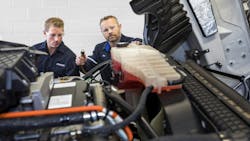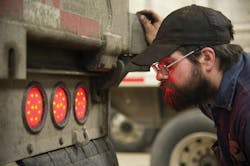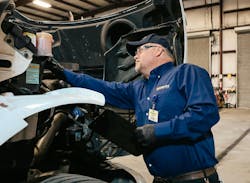For more on inspections:
Preventive maintenance is by far the best defense against unplanned downtime and shortened component life, and it’s hard to imagine any fleet would argue against the value of PMs.
But does every fleet value PM schedules the same way?
First, let’s establish what we mean by schedule. A common way to define the PMs are assigning them A, B, C, or D. An “A” PM involves cleaning and lubrication, like an oil change, and happens the most frequently. “B” is reserved for calibration, adjustments, and diagnostic trouble code checks, “C” for component replacements, alignments, and Department of Transportation inspections. “D” is for rebuilds and seasonal service.
Now to answer the question: No, they do not.
At least that’s in regards to hitting “C” level annual inspections, according to Thomas Bray, sr. industry advisor at J. J. Keller & Associates.
“In 2024, as of mid-December, not having proof of a current periodic/annual inspection was something that was written up on almost 190,000 roadside inspection reports,” Bray explained. “This makes no proof of periodic/annual inspection compliance the number four and number five roadside inspection violations—because there are two different violation codes.”
Operators can incur up to $1,000 per day fines, or $10,000, for each violation. Failing to comply can add up to even more than ignoring an engine issue and having a breakdown, and the government takes enough of your revenue already. So to help stay in compliance, here’s what you need to know about annual inspections.
What needs inspecting?
First off, according to the Federal Motor Carrier Safety Administration, commercial vehicle operators must conduct inspections every 12 months, covering at a minimum: braking systems, coupling devices, exhaust systems, fuel systems, lighting devices, safe loading, steering, suspension, frames, tires, wheels and rims, windshield glazing and wipers, motor coach seats (if applicable), and rear impact guards.
These records need to be kept for 14 months by the motor carrier, while the vehicles must have a sticker, decal, or report on the vehicle. Inspectors can be in-house employees, though must have the proper training and credentials. The inspector records need to be kept by the fleet for at least a year after they cease their duties.
Bray reported that common reasons for roadside inspection failures include:
- The carrier did not know about the requirement.
- The carrier did not know that the requirement. applied to the vehicle (there is a misunderstanding when it comes to non-CDL CMVs and trailers, especially lightweight trailers, which are covered by these requirements).
- The carrier believed there was a “grace period.” but the inspection must be done by the end of the month; there is no grace period beyond that due date.
- The carrier lost track of when it was due and missed it.
- The driver was unable to locate the proof of inspection (it is not the officer’s responsibility to locate the copy of the report or the sticker).
PM multi-tasking
According to Thomas Bray, sr. industry advisor at J. J. Keller & Associates, consider the following list of common PMs to perform along with regulatory required periodic/annual inspections:
- A full and complete inspection of the vehicle
- Front end/all axle alignment
- Replacement (or rebuild) of components that have reached the end of their expected life cycle/service life
- Removal of all viewing plates and inspection of hidden components (such as for clutch wear)
- Oil and other fluid sampling/analysis
- Replacement/repair of non-inspection items that have become questionable (such as mirrors that have become cloudy)
- Retorquing/tightening of specific components
Additional considerations
Joe Puff, VP of truck technology & maintenance at NationaLease advised that in addition to the usual preventive maintenance inspections, it’s a good idea to complete a thorough test of the cooling system, including inhibitors/freeze protection, and a complete test of the charging and starting electrical systems. For components like A/C, coalescing filter, air dryer cartridge, wheel ends, engine air filters, transmissions, and differentials, intervals need to be scheduled for the vehicle’s application, he added.
“Many component intervals are based on time and mileage,” Hough said. “However, with the evolution of connected vehicles and components, the industry is moving toward application-based models that drive efficiency by using data to predict the most optimal intervals.
“In terms of a follow-up repair list,” Hough continued, “a driving factor is the quality of PMs completed between the annual inspections. The level of inspections and PMs completed between annual inspections and the quality of follow-up repairs after each PM event will dictate and mitigate the number of repairs required during annual inspections.”
Emissions systems are another area to focus on. Forgie noted that with modern SCR systems it’s essential to monitor the quality of regens. “We connect to the truck and look for any issues that could be presenting themselves,” he said.
“During annual inspections, expect to see more in-depth diagnostics,” Kelly related. “Areas where there would be reported findings would not be limited to the braking system, coupling devices, frame, and suspension.”
“To maximize efficiency, we often align the timing of the annual inspection with scheduled maintenance,” Richardson added. “Combining the two ensures a comprehensive approach without redundancy, saving time and reducing the likelihood of unexpected findings.”
Blaine Brothers also recommends incorporating oil sampling into a maintenance strategy to allow for precise analysis of contamination levels and wear metals. For trailers, regular inspections of brake components, tarp systems, and structural integrity ensure that equipment is in top condition.
About the Author

Seth Skydel
Seth Skydel, a veteran industry editor, has more than 36 years of experience in fleet management, trucking, and transportation and logistics publications. Today, in editorial and marketing roles, he writes about fleet, service, and transportation management, vehicle and information technology, and industry trends and issues.


